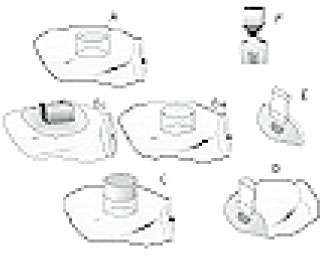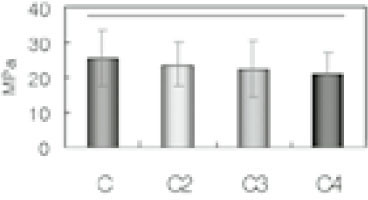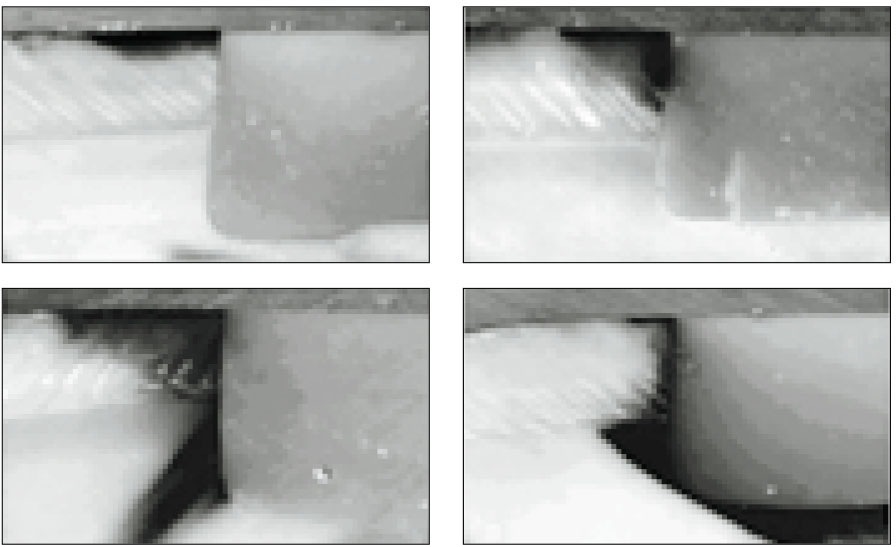J Korean Acad Conserv Dent.
2002 Sep;27(5):479-487. 10.5395/JKACD.2002.27.5.479.
Effects of cavity configuration on bond strength and microleakage of composite restoration
- Affiliations
-
- 1Department of Conservative Dentistry, Division of Dentistry, Graduate School, Kyung Hee University, Korea.
- KMID: 1987304
- DOI: http://doi.org/10.5395/JKACD.2002.27.5.479
Abstract
- No abstract available.
Figure
Reference
-
1. Feilzer AJ, De Gee AJ, Davidson CL. Quantitative determination of stress reduction by flow in composite restorations. Dent Mater. 1990. 6:167–171.
Article2. Kemp-Scholte CM, Davidson CL. Complete marginal seal of class V resin composite restorations effected by increased flexibility. J Dent Res. 1990. 69:1240–1243.
Article3. Alster D, Feilzer AJ, De Gee AJ, Davidson CL. Polymerization contraction stress in thin resin composite layers as a function of layer thickness. Dent Mater. 1997. 13:146–150.
Article4. Davidson CL, van Zegbroeck L, Feilzer AJ. Destructive stresses in adhesive luting cements. J Dent Res. 1991. 70:880–882.
Article5. Jorgensen KD, Asmussen E, Shimokobe H. Enamel damages caused by contracting restorative resins. Scand J Dent Res. 1975. 83:120–122.
Article6. Davidson CL, De Gee AJ, Feilzer AJ. The competition between the composite-dentin bond strength and the polymerization contraction stress. J Dent Res. 1984. 63:1396–1399.
Article7. Asmussen E. Composite restorative resins: composition versus wall-to-wall polymerization contraction. Acta Odontol Scand. 1975. 33:337–344.
Article8. Stansbury JW. Synthesis and evaluation of novel multifunctional oligomers for dentistry. J Dent Res. 1992. 71:434–437.
Article9. Byerley TJ, Eick JD, Chen GR, Chappelow CC, Millich F. Synthesis and polymerization of new expanding dental monomers. Dent Mater. 1992. 8:345–350.
Article10. Eick JD, Byerley TJ, Chappell RP, Chen GR, Bowles CQ, Chappelow CC. Properties of expanding SOC/epoxy copolymers for dental use in dental composites. Dent Mater. 1993. 9:123–127.
Article11. Munksgaard EC, Hansen EK, Kato H. Wall-to-wall polymerization contraction of composite resins versus filler content. Scand J Dent Res. 1987. 95:526–531.
Article12. Hansen EK. Effect of cavity depth and application technique on marginal adaptation of resins in dentin cavities. J Dent Res. 1986. 65:1319–1321.
Article13. Kemp-Scholte CM, Davidson CL. Marginal sealing of curing contraction gaps in class V composite resin restorations. J Dent Res. 1988. 76:841–845.
Article14. Krejci I, Lutz F. Marginal adaptation of class V restorations using different restorative techniques. J Dent. 1991. 19:24–32.
Article15. Liberman R, Ben-Amar A, Herteanu L, Judes H. Marginal seal of composite inlays using different polymerization techniques. J Oral Rehabil. 1997. 24:26–29.
Article16. Feilzer AJ, Dooren LH, De Gee AJ, Davidson CL. Influence of light intensity on polymerization shrinkage and integrity of restoration- cavity interface. Eur J Oral Sci. 1995. 103:322–326.
Article17. Davidson-Kaban SS, Davidson CL, Feilzer AJ, De Gee AJ, Erdilek N. The effect of curing light variations of bulk curing and wall-to-wall quality of two types and various shades of resin composites. Dent Mater. 1997. 13:344–352.
Article18. Sakaguchi RL, Berge HX. Reduced light energy density decreased post-gel contraction while maintaining degree of conversion in composites. J Dent. 1998. 26:695–700.
Article19. Kemp-Scholte CM, Davidson CL. Marginal integrity related to bond strength and strain capacity of composite resin restorative systems. J Prosthet Dent. 1990. 64:658–664.
Article20. van Meerbeek B, Willems G, Celis JP, Roos JR, Braem M, Lambrechts P, Vanherle G. Assessment by nano-indentation of the hardness and elasticity of the resin-dentin bonding area. J Dent Res. 1993. 72:1434–1442.
Article21. Choi KK, Condon JR, Ferracane JL. The effects of adhesive thickness on polymerization contraction stress of composites. J Dent Res. 2000. 79:812–817.
Article22. Feilzer AJ, De Gee AJ, Davidson CL. Setting stress in composite resin in relation to configuration of the restoration. J Dent Res. 1987. 66:1636–1639.
Article23. Feilzer AJ, De Gee AJ, Davidson CL. Setting stresses in composites for two different curing modes. Dent Mater. 1993. 9:2–5.
Article24. deGee AJ, Feilzer AJ, Davidson CL. The linear polymerization shrinkage of unfilled resins and composite determined with a linometer. Dent Mater. 1993. 9:11–14.25. Sano H, Shono T, Sonoda H, Takatsu T, Ciucchi B, Carvalho R, Pashley DH. Relationship between surface area for adhesion and tensile bond strength - Evaluation of a micro-tensile bond test. Dent Mater. 1994. 10:236–240.
Article26. Nakajima M, Sano H, Burrow MF, Tagami , et al. Tensile bond strength and SEM evaluation of caries-affected dentin using dentin adhesives. J Dent Res. 1995. 74:1679–1688.
Article27. Yoshikawa T, Sano H, Burrow MF, Takatsu T, Yoshiyama M, Ciucchi B, et al. Cavity bonding: effect of dentin depth in Dentin/pulp Complex 1995 and the International Meeting on Clinical Topics of Dentin/pulp Complex. 1995. Tokyo: Quintessence Publishing Co., Ltd.;357–358.28. Bouschilcher MR, Vargas MA, Boyer DB. Effect of composite type, light intensity, configuration factor and laser polymerization on polymerization contraction forces. Am J Dent. 1997. 10:88–96.29. Yoshikawa T, Sano H, Burrow MF, Tagami J, Pashley DH. Effects of dentin depth and cavity configuration on bond strength. J Dent Res. 1999. 78:898–905.
Article30. Clinical Research Associates. Product use survey. CRA Newsletter. 1995. 19:1–4.31. Qvist V, Qvist J, Mjor IA. Placement and longevity of tooth-colored restorations in denmark. ACTA Odontol Scand. 1990. 48:305–311.
Article32. Lutz F, Krejci I, Barbakow F. Quality and durability of marginal adaptation in bonded composite restorations. Dent Mater. 1991. 7:107–113.
Article33. Davidson CL, De Gee AJ. Relaxation of polymerization contraction stresses by flow in dental composites. J Dent Res. 1984. 63:146–148.
Article34. Pashley DH, Sano H, Ciucchi B, Yoshiyama M, Carvalho RM. Adhesion testing of dentin bonding agents: A review. Dent Mater. 1995. 11:117–125.
Article35. Willems G, Lambrechts P, Braem M, Celis JP, Vanherle GA. Classification of dental composites according to their morphological and mechanical characteristics. Dent Mater. 1992. 8(5):310–319.
Article36. Miyazaki M, Hinoura K, Onose H, Moore BK. Effect of filler content of light-cured composites on bond strength to bovine dentine. J Dent. 1991. 19(5):301–303.
Article37. Zidan O, Asmussen E, Jorgensen KD. Correlation between tensile and bond strength of composite resins. Scand J Dent Res. 1980. 88(4):348–351.
Article38. Boyer DB, Chalkley Y, Chan KC. Correlation between strength of bonding to enamel and mechanical properties of dental composites. J Biomed Mater Res. 1982. 16(6):775–783.
Article39. Swift EJ Jr, Perdigao J, Heymann HO. Bonding to enamel and dentin: A brief history and state of the art. Quintessence Int. 1995. 26:95–110.40. Ryu GJ, Park SJ, Choi KK. The effect of cavity configuration on the mechanical properties of resin composites. J Korean Acad Conserv Dent. 2002. 27:239–248.
Article41. Uno S, Tanaka T, Inoue S, Sano H. The influence of configuration factors on cavity adaptation in compomer restorations. Dent Mater J. 1999. 18:19–31.
Article
- Full Text Links
- Actions
-
Cited
- CITED
-
- Close
- Share
- Similar articles
-
- Microleakage and Shear Bond Strength of Biodentine at Different Setting Time
- Evaluation of Shear Bond Strength and Microleakage of Self-adhesive Giomer
- The effect of C-factor and volume on microleakage of composite resin restorations with enamel margins
- Microleakage of composite resin restoration according to the number of thermocycling
- Comparison of microleakage after load cycling for nanofilled composite resin fillings with or without flowable resin lining







